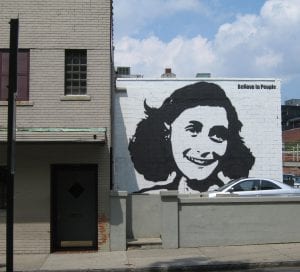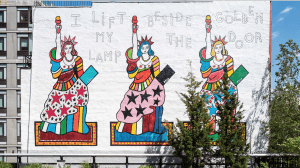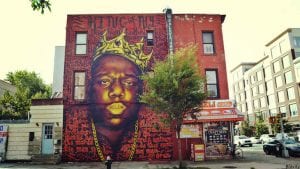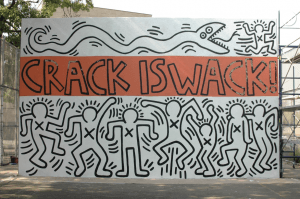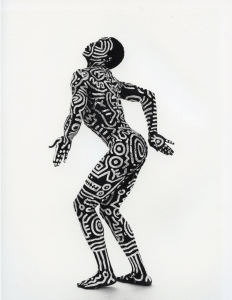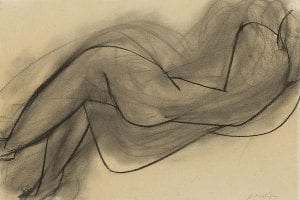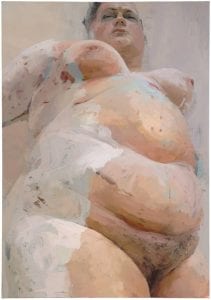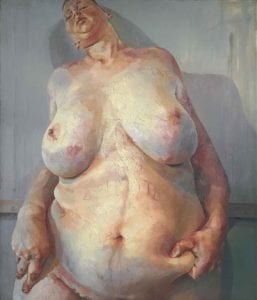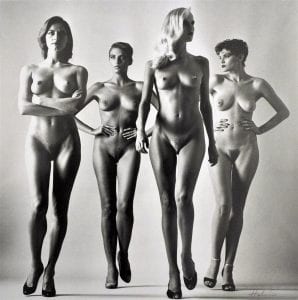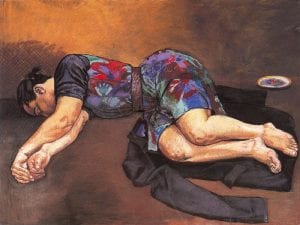I chose to write about the mural of Anne Frank painted on the side of Partner’s, because it is located on one of my favorite spots in New Haven and has sparked many conversations because of its specific placement. After reading “Diary of Anne Frank” in fifth grade, I was deeply influenced and fascinated by Anne Frank and her tragic story as many people are. In the book, she is growing up and writing about typical teenage girl experiences that I related to at the time but, simultaneously living in a situation beyond imagination in its terror and inhumanity. I got to visit her home later on and was greatly affected when I was physically standing in the home she hid in for 25 months. I love how it depicts her smiling with pure joy and the way the artist, Believe in People, used only the stark contrast of black and white to depict this iconic image that we can all recognize immediately. Independently I love this mural and what it represents in honoring her and her bravery, yet its placement in New Haven is extremely bizarre to me. After dancing at Partner’s and leaving through the front door, it’s jarring to see groups of people drinking and smoking in front her image. It feels almost disrespectful to have this serious and meaningful image placed where no one is actively looking at it and admiring it. Or maybe I have the wrong mindset, and by having her integrated into the cityscape in a place people enjoy and visit often is a move of great respect and remembrance.
Monthly Archives: September 2018
3 Liberties
The High Line in New York serves as an important platform for public art in the city, featuring wall murals, sculptures, performances, and video installations. One piece that I noticed this summer, when walking along the High Line with hundreds of other New Yorkers and tourists alike, was a massive mural by Dorothy Iannone.
Covering a wall adjacent to the High Line at 22nd street, the mural features three colorful Statues of Liberty on a white background. Between the figures, the text “I lift my lamp beside the golden door” is written. These words are the final line from the Emma Lazarus’s poem “The New Colossus,” which is engraved on a plaque inside the Statue of Liberty. The poem speaks to the freedom promised by immigration to America. I find the mural inspiring because at a time of heated political debate in reference to immigration in the United States, Iannone has depicted three vibrant, powerful, and proud Statues of Liberty that shed some light and joy to a topic that has caused so much pain and agony as of late.
The mural was commissioned for the wall from March 2018 to March 2019.
King of NY
Biggie Smalls is the illest
(Unbelievable)
Yeah, this album is dedicated/ To all the teachers that told me I’d never amount to nothin’/ To all the people that lived above the buildings that I was hustlin’ in front of/ Called the police on me when I was just tryin’ to make some money to feed my daughter (it’s all good)/ And all the niggas in the struggle/ You know what I’m sayin’? It’s all good, baby baby,
(Juicy)
The Notorious B.I.G — also known as Biggie Smalls, Biggie, and Big Poppa — is an undeniable icon. His icon was a multi-faceted one representing a genre of music, a decade, a city, and a neighborhood. Without him all the Cardis, Drakes, and Kanyes may not exist. So it feels almost obvious that someone of his status, especially given his death at such a young age (24), would be immortalized in a mural. It feels even more obvious given his place of birth, New York City.
In 2015 two street artists, Rocko and Zimer, created a two story mural of Biggie, titled “King of NY,” in the neighborhood which Biggie grew up in, Bed Stuy. The landlord of the building wished to take it down, but after public outrage decided to keep the mural. To me, this mural functions in a number of ways. It beautifies the neighborhood and creates a sense of pride in the neighborhood. It also serves as a source of inspiration — everyone walking by can think to themselves “he was once where I am and now he’s a huge mural and known as the King of NY.”
Public Art Project: Keith Haring’s “Crack is Wack”
For this week’s blog post, I chose to discuss Keith Haring’s Crack is Wack mural, a public painting that I have often driven by along the FDR. Although the double-sided mural has undergone restoration since it was first painted, it still stands today. The mural was created using the wall of a deserted handball court, which grants the work with the appearance of a large billboard that you might drive by, especially considering that it stands so close to the highway. Haring’s mural was relevant to New York City, specifically, as it referenced the high use of crack cocaine and Reagan’s “War on Drugs” that were both especially prevalent in New York City.
Side one
An After-Hours Soads Surprise
My mini-exhibition highlights the relationship between art and avant-garde music. Staged in an exclusive Saturday night after-hours Toad’s event, Romare Bearden’s “Empress of the Blues” and “Wrapping it up at the Lafayette” lie hidden, unlabeled beside both works in progress and those recently completed. Musicians stand in physical isolation across the room listening to each other and spinning melodies reminiscent of late 1960s free jazz. While the dim lighting blurs the boundaries between hung works from the rising artists in attendance and those of established masters such as Bearden, the live musical improvisation illuminates their shared spontaneity.
The “Empress of the Blues” hangs eye-level in a narrow hallway between the dance floor and lower level where the old walls muffle higher and distort lower frequencies. The painting, just like the empress’s eyes, greatly contrasts its surroundings. Because of the piece’s position in the hallway, the observer must face its brutally vivid chunks of color. Combined with the unsettling soundscape, the positioning makes the viewer feel both uncomfortably out of their time and awed by the painting’s sheer beauty. Just like the female singer, deemed the Empress in a band full of men, likely felt torn between her love of jazz and her disdain for the position she held within a patriarchal society.
By the exit of the exhibition, Bearden’s “Wrapping it up at the Lafayette” evokes strong contrast between four seemingly unrelated scenes at the Lafayette nightclub. While the color schemes of each depiction are strikingly dissimilar, Bearden places musicians in the foreground that cast single feel across the entire work. The viewer may feel that the painting acts as a metaphor for the night at the after-hours event, where music brought together seemingly unrelated works of art and collections of people.
Outside the exhibition, Arnold Schoenberg’s disturbing Self Portrait stares the attendants directly in the eye, reminding of the similarities between them and their artistic works. Just as he pioneered early atonal music that can both ease and jar its listeners, Schoenberg stands with soothingly cool blue skin and a missing left ear. Artists should be mindful of the art they create, as it ultimately defines who they become.


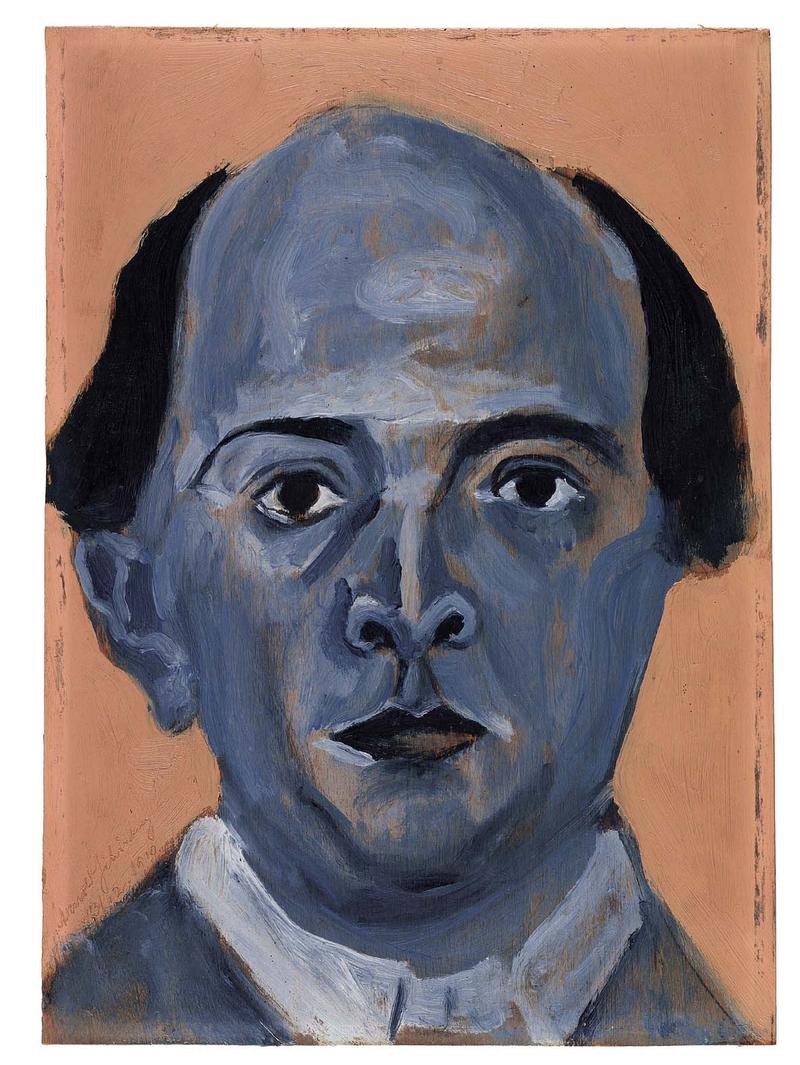
Phantoms of Motion
My two piece exhibition featured Edgar Degas’ The Bath and Bill T. Jones by Tseng Kwong Chi and Keith Haring:
The conversation between these two pieces focused on captured movement and potential energy. As a curator, I wanted to emphasize that the art here is not necessarily in the artists’ representation of the body, but in the contortion and motion of the body itself. In these two works, the bodies are frozen in one moment in time, but with my third object I wanted to break through that barrier of solid lines and definite borders of the body. Henri Matisse’s Nu couché de dos (Reclining nude, back view) captures a sense of continuous movement not seen in the other two pieces.
Not only does the movement of the figure appear in the drawing, but so does the movement of the artist, Matisse, as he rejects each prior line, changes his position or perspective, and reconstructs the figure before him piece by piece. In one drawing, he depicts countless bodies, each in a slightly different position than the one before like the images of a flip book drawn on pieces of transparent paper and layered on top of one another. The smudged erasures enact a similar vibration in the eye as the rapid, layered strokes of Degas’ painting or the optical illusion caused by the white stripes and shapes juxtaposed by the deep black of Bill T. Jones’s body, but adds something more like the phantoms of moments just passed or soon to come.
Another Nude Perspective

My mini-exhibit features one white male nude and one black male nude (“O’Hara Nude with Boots” by Larry Rivers and “Brilliantly Endowed (Self Portrait)” by Barkley L. Hendricks) in conversation about questions of physical boundaries, mythology, and artistic gatekeeping. I can’t say I have any figurative artists that I love, but I stumbled across this nude painting by Douglas Simonson and thought it’d be an interesting addition to my project. An artist who blends acrylic paints, pencil sketches, and digital technologies to complete his works, Simonson himself refers to this work, entitled “California Desert,” as an “Impressionist painting of [a] statuesque Black male nude.” Visually, there are similarities between this painting and Rivers’, mainly the broader brushstrokes that blend the colors and their portrayals of men as statues, more specifically, men as symbols of vitality, power, and creative energy. Like Rivers, Simonson is a white man, which I find interesting because, though he is representing a black subject, the representation has similar motifs to other white works. Conversely, Hendricks presents a black subject like Simonson does, but unlike Simonson Hendricks is interested in presenting his subject, in this case himself, as an individual, with readily identifiable personality traits and stylistic choices. Hendricks’ work is more casual while Simonson’s still retains this formality even with the relaxed setting in the backdrop. Thus, I think Simonson’s work is an intriguing addition to my exhibit, as we see an artistic and cultural crossover that brings some of the ideas I’m fascinated by into starker relief.
Unflinching Gaze



My original exhibition featured Jean Auguste Dominique Ingres’ Grande Odalisque and Lucian Freud’s Night Portrait, Face Down. Through the exhibition I hoped to challenge our fear of expressing the true emotions we feel toward art works. It’s better that we call out the ugly as ugly, the beautiful as beautiful. Only then can we see the truth each works tries to tell us. Masking ugliness with beauty can be dangerous because often times ugliness demonstrates truth better than beauty can. By adding Vermeer’s The Milkmaid to the pair, I wanted to further emphasize this point. Vermeer’s penchant for realistic capture of mundane everyday scenes enlightens us to the value of perceiving and expressing life as life is. Though the milkmaid is neither a nymph nor a queen, she captivates our gaze. Though her body is neither exaggerated nor distorted, she demonstrates the tangible reality within which she resides. The idea behind the exhibition isn’t to impose a hierarchy between the different approaches by the artists, namely that realism triumphs aestheticizing or brutalizing brushstrokes. Each of these approaches are just as valid as the other. What is important, however, is to recognize them for what they are. Realize that the Grande Odalisque is a fantastic, Orientalized work. Acknowledge that the Night Portrait is not particularly pleasing to the eye. Only through such unflinching gaze can we fully appreciate the narrative each painting tells us.
Bodies in Contrast
In my original exhibition, I chose to hang two Saville pieces within a mirrored corridor. The exhibition was located in an empty store front across the street from a Versace store. The intent was to push the viewer to recognize and become aware of depictions of bodies, from the way the fashion world expects bodies to look to the way certain artists choose to portray them.
In an effort to push this comparison one step further, and provoke an interesting conversation, I would hang a photograph by Helmut Newton on the wall outside the exhibition. Newton was a famous photography, known for his work in the fashion industry. His images feature the conventional beauty of models, often presented in a highly sexualized image. The image below was part of a Louis Vuitton campaign. I think this image, of four thin, nude women, posing for a high fashion campaign, would contrast sharply with the two Saville pieces that depict larger women, shunned from the fashion world, and generally criticized for the body type.
Three Naked Women
Naked Portrait with Reflection by Lucian Freud acts as an antithesis, in a way, of the two pieces I chose for my mini-exhibition while also fitting in with them. All of the paintings are their own portrayals of nakedness and vulnerability and in that way, they all collide and work together to create an atmosphere of vulnerability and give the viewer the role of a voyeur. In the first two pieces I selected, both by Paula Rego, both women are clothed but left open to the gaze of the viewer that neither of them would be aware of. The first piece, which is darker in color, works against the second, which is much lighter in those aspects. The bodies in each juxtapose each other in the way they are positioned as in one work, it appears as if the subject had a turbulent nap while the in the other, the subject seems calm and in a heavy sleep. This piece by Freud, in my mind, works as a culmination of the two. The body shape is turbulent and disturbed but the lines and shapes are lumpy and smooth; the body relaxed and heavy. The painting is light but also dull and mundane, and the clothes have been stripped away. With all three paintings, we are left wondering the stories of these women and how they ended up in each of these situations and each of these positions.

